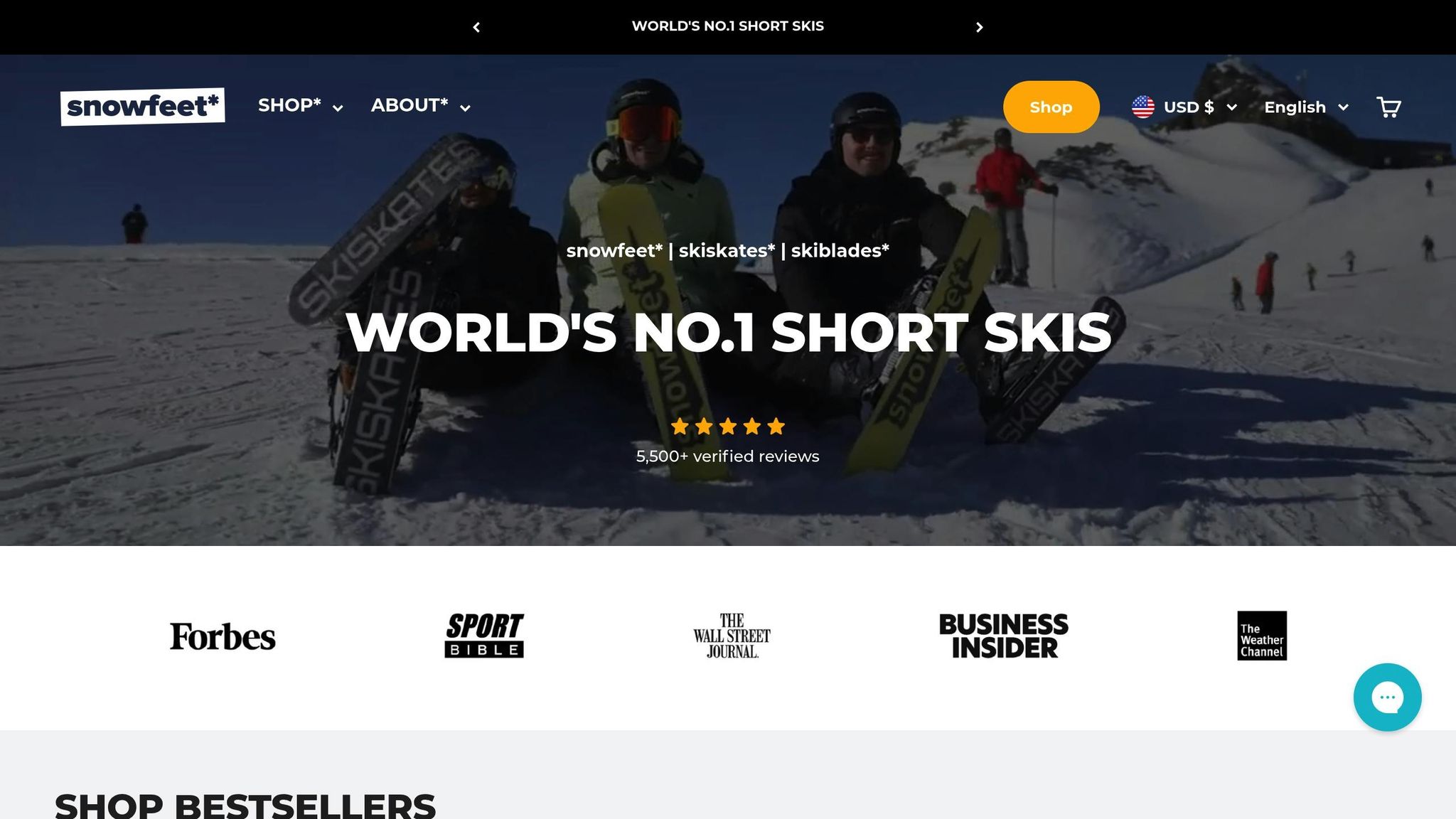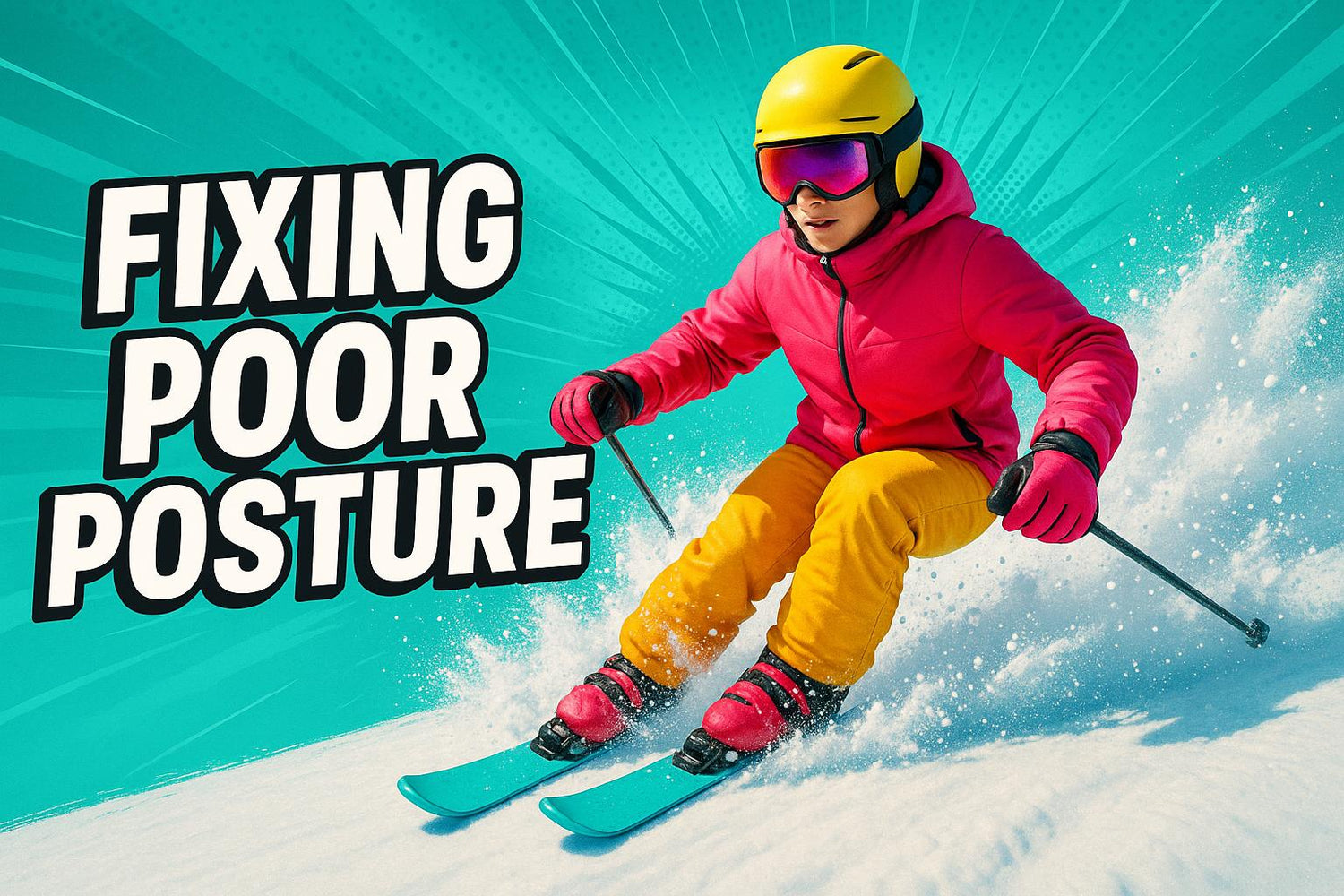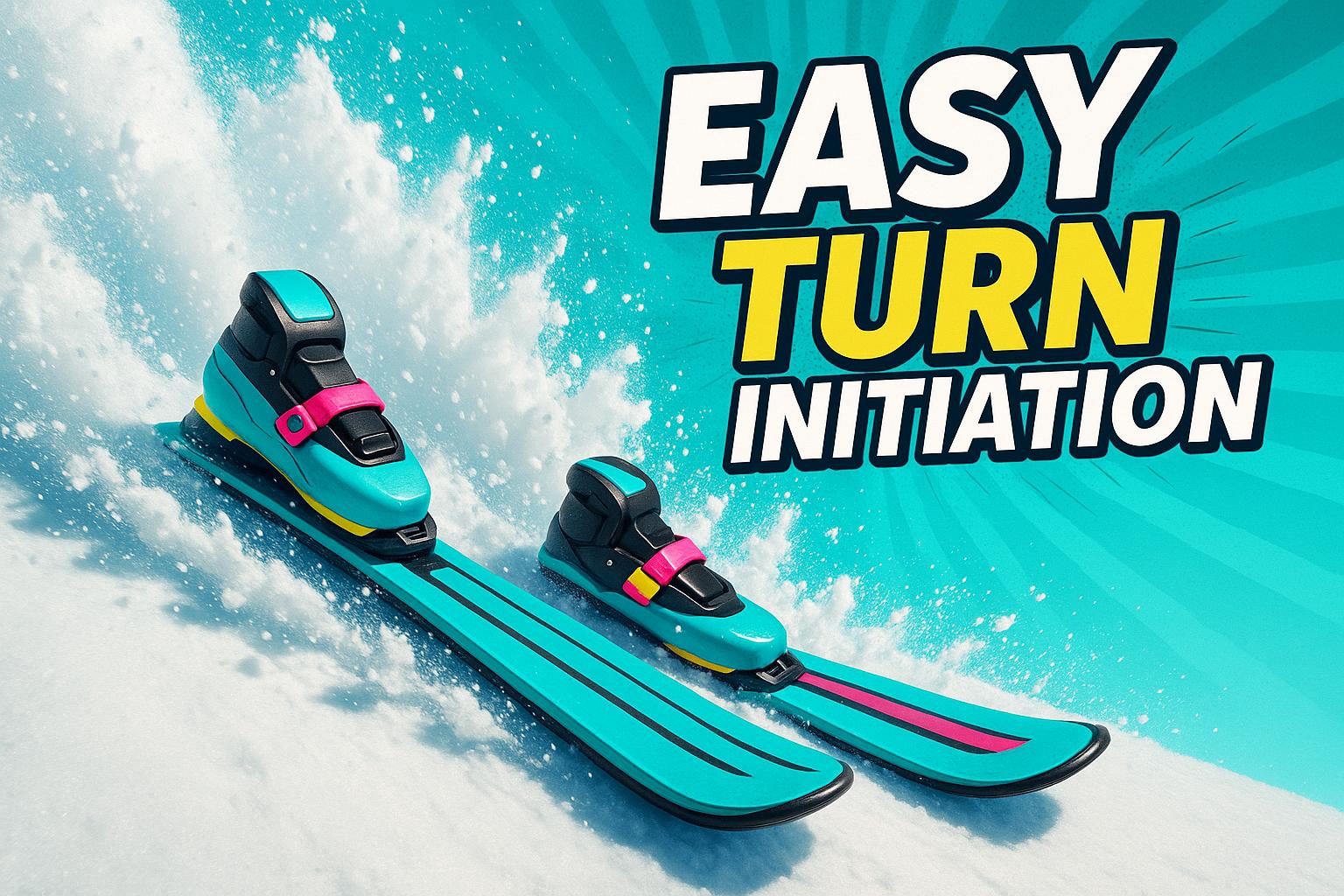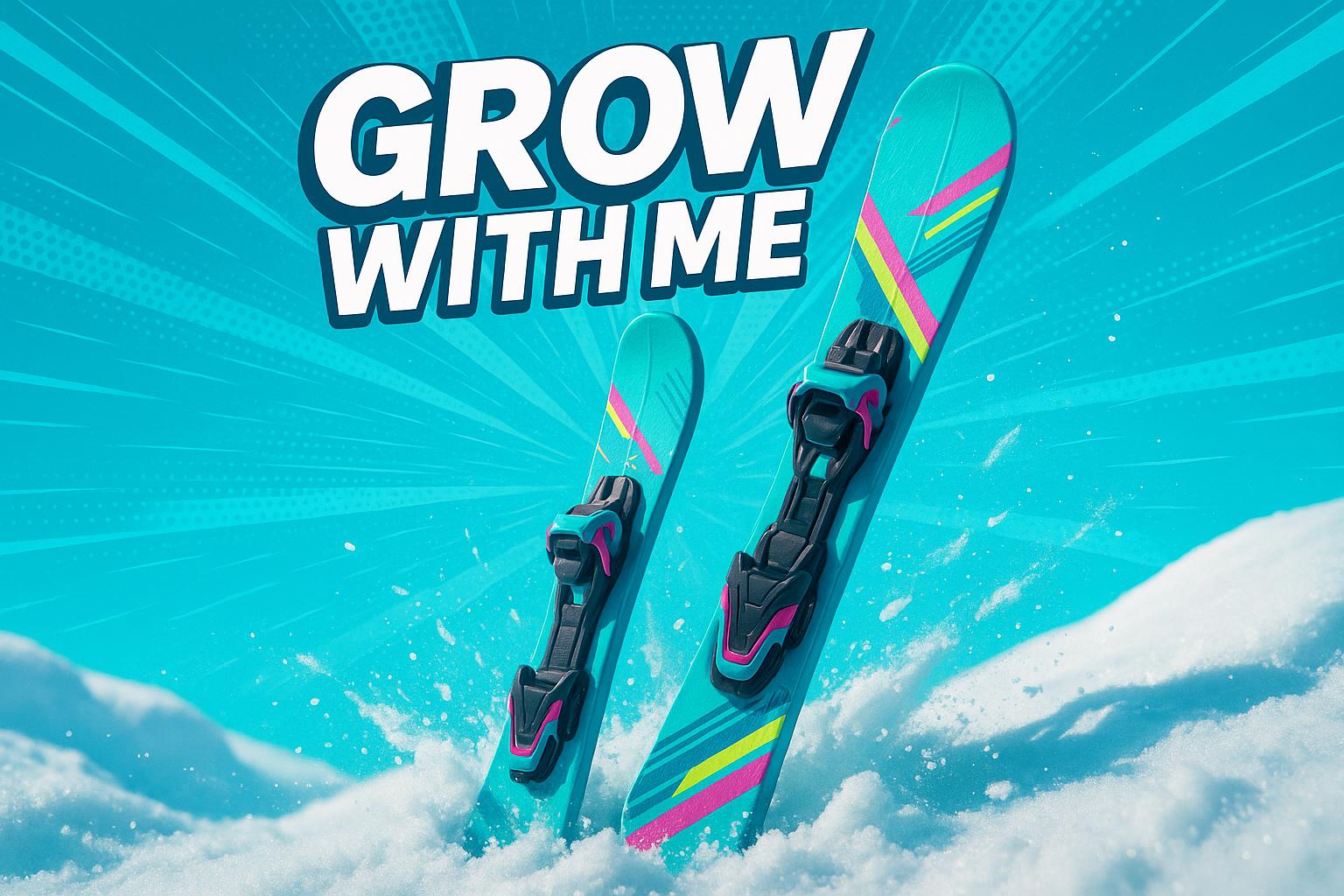When using short skis like Snowfeet* Skiblades, poor posture can ruin your balance, control, and fun on the slopes. Common mistakes - like leaning too far forward or back, staying stiff, or sticking to habits from long skis - make it harder to turn, stop, or enjoy the ride. The good news? Fixing your posture is simple:
- Center your weight: Stand upright with weight over the middle of your feet, not leaning forward or back.
- Keep knees bent: Stay flexible to absorb bumps and terrain changes.
- Use edges properly: Shift weight to edges for smoother turns and better control.
Short skis demand precise posture but reward you with agility, easier turns, and less fatigue. Ready for smoother, longer runs? Let’s fine-tune your stance and make the most of your Snowfeet* Skiblades!
Average Skiers Improving Their Posture and Balance | Camp Vlog
Common Posture Mistakes When Using Short Skis
Switching from long skis to Snowfeet* Skiblades can feel like stepping into a whole new world. The techniques and stance that worked on longer skis often don’t translate to these shorter, more responsive skis. Even small posture errors can throw off your balance and control.
Leaning Too Far Forward or Backward
Leaning back is one of the biggest no-nos when using short skis. It lifts the ski tips off the snow, making it much harder to edge and steer. Nancy Hummel, a seasoned instructor, explains it best:
Leaning back "limits access to edging and rotary. Requires much more energy."
Short skis, like Snowfeet* Skiblades, demand precise weight distribution. Leaning too far forward isn’t great either - it puts too much pressure on the ski tips, causing the tails to lose grip. This makes smooth turns nearly impossible. Unlike traditional long skis, which can handle a bit of imbalance, short skis require you to nail that weight balance for proper control.
Staying Too Stiff
If your body is stiff, you’re setting yourself up for trouble. Locking your knees, ankles, or hips limits your ability to adjust to uneven terrain. The best skiers keep their lower bodies loose, letting their legs absorb bumps and adapt to changes. If you’re stiff, you’ll end up relying on your upper body to compensate, which leads to awkward, forced turns. Snowfeet* Skiblades are built for quick reactions, so staying relaxed and flexible is essential.
Sticking to Long Ski Posture Habits
Old habits die hard, but the stance that worked on long skis can really mess with your performance on short skis. Long skis are more forgiving, but Snowfeet* Skiblades need a forward, centered stance to grip the snow and make sharp turns. Many skiers instinctively use a wide stance, but a narrower, more centered position gives you better control with these shorter skis. François Pugh, an experienced skier, puts it simply:
"Centered is not back. Just say'n."
What feels “centered” on long skis might actually be too far back for short skis. Adjusting your stance is key to unlocking their potential. Now that you know the common mistakes, it’s time to learn how to correct them!
How to Fix Poor Posture for Short Skiing
Getting your posture right on Snowfeet* Skiblades can make all the difference between a smooth, controlled ride and a wobbly, unpredictable one. Let’s break down some simple adjustments to help you get the most out of your time on the slopes.
Center Your Weight Over the Skis
When you're using short skis like Snowfeet* Skiblades, weight distribution is key. Unlike traditional long skis from brands like Rossignol or Atomic, which can handle a forward lean, Snowfeet* Skiblades require a more upright stance. As the Snowfeet Team explains:
"Don't lean forward like you would do with skis, because you don't have the support of regular-length skis to hold you and with almost inevitable certainty, you would fall down. Instead, stand up straight and place your weight over the middle and back of your feet."
In simpler terms, keep your body upright and let your weight rest over the middle and slightly back on your feet. For added stability, stand with your feet about shoulder-width apart or stagger one foot slightly ahead of the other when tackling more challenging terrain. Adjust as needed: lean toward your toes for backward maneuvers or shift to your heels when riding over bumps. The compact size of Snowfeet* Skiblades makes these small shifts incredibly effective.
Keep Your Knees Slightly Bent and Flexible
Stiff legs are a no-go when you're riding short skis. Instead, aim for an athletic stance: feet shoulder-width apart, knees relaxed, and ankles flexed with your shins pressing gently forward. This lowers your center of gravity and keeps your knees ready to absorb bumps or adapt to uneven terrain.
Snowfeet* Skiblades are designed to be nimble, with a smaller turning radius and forgiving flex that reduce strain on your knees compared to longer skis. And let’s be real - falls happen. Keeping your knees bent can help prevent them from locking up during a tumble, reducing the risk of injury.
Use the Edges for Better Control
Edge control is what separates confident riders from everyone else. With Snowfeet* Skiblades, shifting your weight to the edges and applying pressure helps you dig into the snow, creating the friction you need to slow down or stop. For carving turns, focus on putting weight on the outside edge of the front leg while pressing the inside edge of the back leg.
These small adjustments will give you better control and make every run feel smooth and fun. Snowfeet* Skiblades are all about precision, and mastering edge control ensures you’re riding with confidence.
sbb-itb-17ade95
Why Proper Posture Makes Short Skiing with Snowfeet* Better

Getting your posture right when using Snowfeet* Skiblades can completely change your skiing experience. Unlike traditional long skis, these shorter skis - ranging from 25 to 47 inches (65–120 cm) - are designed to perform best when your body positioning is spot on. Let’s break down why proper posture is such a game-changer.
Better Stability and Agility
When you maintain a centered, upright stance, Snowfeet* Skiblades become incredibly responsive. Their short design works with your movements, allowing for quick shifts in weight and smooth edge transitions. This is especially handy in tight spots or challenging terrain where longer skis, like those from Head or Elan, might feel clunky.
Picture navigating through moguls, weaving between trees, or maneuvering on crowded slopes. With Snowfeet* Skiblades, you can make real-time adjustments and pivot with ease. It’s almost like riding a motorcycle on snow - agile, precise, and thrilling.
More Comfort and Less Fatigue
Short skis aren’t just about agility; they’re also easier on your body. Thanks to their lighter weight, they demand less effort to control, which means less fatigue compared to traditional long skis. When you keep your knees slightly bent and your weight centered, you’re working with your body’s natural mechanics, not against them. This lower center of gravity helps reduce muscle strain and keeps you feeling fresh for longer runs.
With Snowfeet* Skiblades, you’ll notice you can ski longer without feeling wiped out. It’s all about conserving energy so you can enjoy more time on the slopes.
More Fun and Freedom on the Snow
Proper posture doesn’t just improve performance - it makes skiing more fun. With better stability and less fatigue, you’ll feel more confident exploring all kinds of terrain. Whether it’s groomed runs, backyard hills, hiking trails, or even urban settings, Snowfeet* Skiblades let you push boundaries in a way that’s hard to match with traditional skis.
Short skis also make turning easier, which is great for beginners looking to build skills quickly. For seasoned skiers, this added control opens up opportunities to get more creative on the slopes. While long skis might have an edge at high speeds, short skis offer unmatched balance and adaptability. When paired with proper posture, Snowfeet* Skiblades turn every run into an adventure, not a workout.
Posture Requirements: Snowfeet* vs Long Skis
When you're skiing with Snowfeet* Skiblades compared to traditional long skis from brands like Rossignol, Atomic, or Head, your body positioning plays a huge role in how you perform, how comfortable you feel, and how much you enjoy the experience.
Posture for Short Skis vs Long Skis
With traditional long skis (usually 59–79 inches in length), the key to staying stable is a forward-leaning posture. This means putting more weight on your shins and constantly pressing against the front of your boots. On the other hand, Snowfeet* Skiblades, which are much shorter (about 25 to 47 inches or 65–120 cm), work best when you adopt a centered, balanced stance. Instead of leaning forward, you keep your weight evenly distributed over the middle of the ski. This allows for a more upright and natural position, which also happens to be less tiring.
Because of their shorter length, Snowfeet* Skiblades respond quickly to subtle weight shifts, so you don’t need that aggressive forward lean to turn. Keeping your knees slightly bent and your core engaged gives you a relaxed yet controlled posture. This difference in stance isn’t just about comfort - it’s what makes Snowfeet* so responsive and fun to use.
Advantages of Short Skis over Long Skis
These posture differences translate into some clear benefits. A centered stance makes it easier to change directions quickly, handle tight turns, and move smoothly through crowded slopes.
For beginners, this posture is a game-changer. It aligns naturally with your body’s balance point, making it easier to learn. Unlike traditional long skis, which require you to master that tricky forward-leaning stance, Snowfeet* let you progress faster and with less frustration.
Another big win? Less muscle fatigue. The relaxed stance and lightweight design of Snowfeet* mean your shins and calves won’t feel overworked, so you can ski longer without needing a break. Plus, their versatility shines - they’re great for everything from groomed runs and high-speed carving to backyard hills and terrain parks. The centered stance makes all this possible, giving you more control and agility no matter where you’re skiing.
Comparison Table: Snowfeet* vs Long Skis
Let’s break it down with a quick side-by-side comparison:
| Feature | Snowfeet* Skiblades | Long Skis (e.g., Rossignol) |
|---|---|---|
| Posture Requirement | Centered, balanced | Forward-leaning |
| Maneuverability | High | Moderate |
| Learning Curve | Quick and easy | Longer |
| Fatigue Reduction | High | Moderate |
| Terrain Flexibility | High | Good |
| Weight Distribution | Even across ski | Forward-focused |
| Muscle Engagement | Relaxed, natural | Aggressive, demanding |
| Turn Initiation | Subtle weight shifts | Pronounced forward pressure |
| Beginner Friendliness | Very high | Moderate |
| Portability | Highly portable | Requires a ski bag or rack |
This table highlights how the balanced posture of Snowfeet* Skiblades enhances agility, simplifies learning, and reduces fatigue. While long skis might have the edge in certain high-speed scenarios, Snowfeet* make skiing more approachable and enjoyable, especially for beginners or those who value versatility and ease of use.
Conclusion: Master Your Posture for Better Short Skiing
Nailing your posture isn’t just about looking sharp on the slopes - it’s the key to unlocking the full potential of Snowfeet* Skiblades. When you adopt a centered, balanced stance with slightly bent knees and an engaged core, you're not just fixing common mistakes; you're setting yourself up for a smoother, more controlled skiing experience. This solid foundation can make a noticeable difference in how you handle the slopes.
What makes Snowfeet* Skiblades stand out is how they respond to proper technique. Unlike traditional long skis from brands like Rossignol or Atomic - which can sometimes mask minor posture flaws - short skis highlight both your strengths and weaknesses. With the right posture, you’ll feel more connected to your movement, enjoy better control, and even reduce fatigue. Their lightweight build and shorter length naturally complement your balance, absorbing shocks and easing muscle strain while giving you that extra edge in agility.
But it’s not just about comfort. This improved control and reduced strain make it easier to progress quickly, whether you’re cruising down groomed runs, hitting terrain parks, or even experimenting in your backyard. Snowfeet* Skiblades are all about versatility, welcoming both beginners and seasoned skiers looking for something fresh.
Before every run, take a quick moment to check your form: hinge at the hips, keep your core tight, bend your knees, center your weight over the skis, and keep your arms forward. This simple habit will help you maintain the posture that brings out the best in Snowfeet*, making them not just fun but incredibly responsive. Short skis may demand precision and quick reflexes, but when you get it right, they reward you with unmatched agility and control.
FAQs
How can I switch from long skis to Snowfeet* Skiblades while maintaining proper posture?
Switching from long skis to Snowfeet Skiblades* might seem like a big change, but it’s actually pretty straightforward when you focus on your posture. The key is to stand balanced and centered - keep your weight slightly forward and your knees slightly bent. This position gives you better control and stability, which is especially important when using shorter skis.
Unlike traditional long skis from brands like Rossignol or Atomic, Snowfeet Skiblades* encourage a more upright stance and make turning a breeze. To stay steady, engage your core and practice smooth, controlled movements. Thanks to their shorter length, Snowfeet* Skiblades make it easier to balance and move around, turning the transition into a fun and manageable experience.
What are the benefits of maintaining good posture when using Snowfeet* Skiblades compared to traditional long skis?
Maintaining good posture while using Snowfeet Skiblades* can seriously level up your skiing game. Their shorter, more agile design makes balancing and staying in control feel way easier, which means less strain on your body and a boost in confidence. Unlike traditional long skis that often demand precise technique just to stay stable, Snowfeet* Skiblades naturally guide you into a stance that feels comfortable and less exhausting.
When you focus on proper posture, you'll notice smoother, sharper turns and an overall more dynamic ride. This setup is great for freestyle tricks or tackling varied terrain. Plus, Snowfeet* Skiblades are super beginner-friendly, offering a fun and approachable alternative to the technical challenges of longer skis from brands like Rossignol or Atomic. Whether you're a pro or just starting out, combining good posture with Snowfeet* Skiblades is a recipe for better comfort, performance, and pure fun on the slopes.
How do Snowfeet* Skiblades help reduce fatigue and improve agility on the slopes?
Snowfeet* Skiblades are all about making your time on the slopes easier and more fun. Thanks to their lightweight, compact design, they’re much simpler to handle than traditional long skis from brands like Rossignol or Atomic. Less bulk means less strain on your legs, so you can ski longer without feeling wiped out.
What really sets Snowfeet* Skiblades apart is their ability to deliver quick, sharp turns with ease. They’re super easy to control, which makes them a great choice for everyone - from beginners trying to save energy to seasoned skiers craving more flexibility and excitement. These shorter skis bring a mix of comfort and performance that traditional skis just can’t offer.


































Leave a comment
This site is protected by hCaptcha and the hCaptcha Privacy Policy and Terms of Service apply.